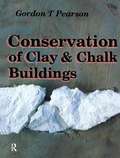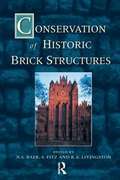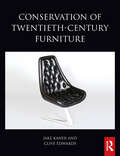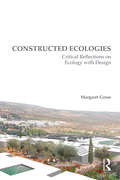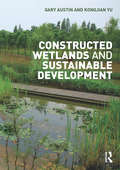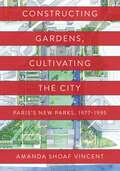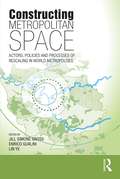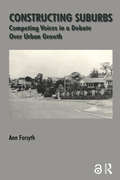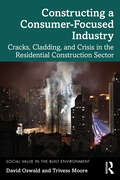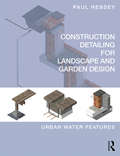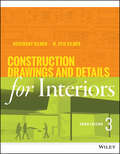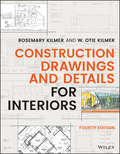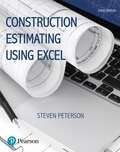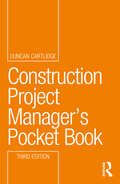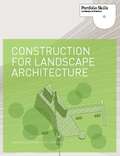- Table View
- List View
Conservation of Clay and Chalk Buildings
by Gordon T. PearsonThis publication provides practical guidance on appropriate methods of conservation and repair of earth buildings using traditional building materials. It is the first major work on the subject since Clough Williams-Ellis and the Eastwick-Fields published "Building in Cob, Pise and Stabilized Earth" in 1947. The book deals with the nature of clay and chalk, their qualities and characteristics, and the way in which they have been used to construct buildings. Advice is given on soils analysis, the philosophy of repair techniques and the factors to be considered before altering, converting or extending an earth building. The author primarily advocates repair techniques using traditional materials, but he also considers the role played by certain modern materials, and assesses their suitability.
Conservation of Historic Brick Structures
by Norbert Baer Fitz LivingstoneDespite the widespread use of brick construction throughout the world, there has been no major investigation into its deterioration and durability. This book provides the results of a major international study led by West Germany which examines the causes of decay in addition to the treatment and methods of conserving brickwork and historic mortars. The deterioration mechanisms discussed cover bio deterioration, salt damage and the effects of air pollutants and moisture on masonry. Considerable attention is also devoted to historic mortars and renders, their analysis, behaviour under the stress of air pollution and the development of compatible modern formulations. Conservation methods for brick masonry, including de-salination, protective coatings and injection grouting are examined in detail. A useful and extensive range of case study material is also provided. This volume represents the most comprehensive, state of the art overview of the conservation of historic brick masonry, and will be an invaluable source of reference for all conservation practitioners and researchers working in this field.
Conservation of Twentieth-Century Furniture (Routledge Series in Conservation and Museology)
by Clive Edwards Jake KanerConservation of Twentieth-Century Furniture provides comprehensive and accessible coverage of the materials and techniques that are encountered in furniture of this century.After putting the design, manufacture and conservation of twentieth-century furniture into context, the volume then offers an A-Z of materials organised into 12 chapters. Within each chapter a wide variety of material types are discussed, observed, analysed and contextualised, and a list of further sources is provided. The furniture discussed in this book ranges from designer craftsman, individually made pieces, to factory-produced batch items, and includes cabinet work, decoration, surface finishes and upholstery, observing the traditional repertoire of materials, as well as innovative materials and processes introduced over the course of this century. Following the material chapters, the book also includes brief case studies that illustrate some examples of twentieth-century furniture conservation, with a focus on metal, plastic and wood.Conservation of Twentieth-Century Furniture is the primary resource for those working on the manufacture, history and care of furniture of this period, including conservators, curators, dealers and collectors.
Consider the Lilies
by Alfreda Oko Martin Edward MartinJapanese flower arranging has attracted a world wide following, and this book is a simple and clear introduction to the art.The first section illustrates thirty-six suggested flower arrangements with diagrams and full how-to-do-it instructions. The second part of the book explains the theory and technique of Japanese flower arrangement. The result is a book which gives an astonishing range of flower arrangements, clear explanations of how to make them at home, and an inspiring selection of devotional passages.
Constructed Ecologies: Critical Reflections on Ecology with Design
by Margaret GroseToday, designers are shifting the practice of landscape architecture towards the need for a more complex understanding of ecological science. Constructed Ecologies presents ecology as critical theory for design, and provides major ideas for design that are supported with solid and imaginative science. In the questioning narrative of Constructed Ecologies, the author discards many old and tired theories in landscape architecture. With detailed documentation, she casts off the savannah theory, critiques the search for universals, reveals the needed role of designers in large-scale agriculture, abandons the overlay technique of McHarg, and introduces the ecological and urban health urgency of public night lighting. Margaret Grose presents wide-ranging new approaches and shows the importance of learning from science for design, of going beyond assumptions, of working in multiple rather than single issues, of disrupting linear design thinking, and of dealing with data. This book is written with a clear voice by an ecologist and landscape architect who has led design students into loving ecological science for the support it gives design.
Constructed Wetlands and Sustainable Development
by Gary Austin Kongjian YuThis book explains how with careful planning and design, the functions and performance of constructed wetlands can provide a huge range of benefits to humans and the environment. It documents the current designs and specifications for free water surface wetlands, horizontal and vertical subsurface flow wetlands, hybrid wetlands and bio retention basins; and explores how to plan, engineer, design and monitor these natural systems. Sections address resource management (landscape planning), technical issues (environmental engineering and botany), recreation and physical design (landscape architecture), and biological systems (ecology). Site and municipal scale strategies for flood management, storm-water treatment and green infrastructure are illustrated with case studies from the USA, Europe and China, which show how these principles have been put into practice. Written for upper level students and practitioners, this highly illustrated book provides designers with the tools they need to ensure constructed wetlands are sustainably created and well manage
Constructing Gardens, Cultivating the City: Paris’s New Parks, 1977-1995 (Penn Studies in Landscape Architecture)
by Amanda Shoaf VincentConstructing Gardens, Cultivating the City is the first cultural history of major new parks developed in Paris in the late twentieth century, as part of the city’s program of adaptive reuse of industrial spaces. Thanks to laws that gave the city more political autonomy, Paris’s local government launched a campaign of park creation in the late 1970s that continued to the turn of the millennium. The parks in this book represent this campaign and illustrate different facets of their cultural and historical context.Archival research, interviews, and analyses of the parks reveal how postmodern debates about urban planning, the historic city, public space, and nature’s presence in an urban setting influenced their designs. In sum, the city adopted the garden as a model for public parks, investing in complex, richly symbolic and representational spaces. These parks were intended to represent contemporary twists on traditional designs and serve local residents as much as they would contribute to Paris’s role as a world city.The parks’ development process often included points of conflict, pointing to differing views on what Parisian space should represent and fundamental contradictions between the characteristics of public space and the garden as it is traditionally defined. These parks demonstrate the ongoing cultivation of the city over time, in which transformed sites not only fulfil new functions but also engage with history and their surroundings to create new meaning. They stand for landscape as a form of signifying cultural production that directly engages with other art forms and ways of knowing. Just as the Luxembourg Gardens, the Tuileries, and the Buttes-Chaumont parks exemplify their eras’ cultural dynamics, such parks as the Jardin Atlantique, Parc André-Citroën, and the Jardin des Halles express contemporary French culture within the archetypal space of their era, the city. Finally, they point the way to current trends in landscape architecture, such as citizen gardening and ecological initiatives.
Constructing Metropolitan Space: Actors, Policies and Processes of Rescaling in World Metropolises
by Lin Ye Jill Simone Gross Enrico GualiniThere is little question today that processes of globalization affect national and local economies, governance processes, and conditions for economic competitiveness in the major urban regions of the world. In most liberal-democratic countries, these processes are occurring according to a rationale which attempts to combine strategies of state-supported development with increasing local-regional governmental decentralization and autonomy. Against this background, the issue of metropolitan development is being redefined worldwide, along with its institutional frameworks, modes of governance, policy instruments, and spatial planning strategies. The overarching assumption of this volume is that ‘metropolitan space’, far from being consolidated as a policy object, is currently being redefined and in some instances ‘constructed’ and contested as a scale, through a variety of policy practices related to spatial-economic development objectives. Through case studies drawn from across four continents, the authors reveal a range of interesting cross-national commonalities concerning the power that state actors, situated at various spatial scales, exert as agents in these processes. This volume interrogates key research issues raised by these developments, and is intended as a contribution to the establishment of a globally comparative analysis of the construction of metropolitan spaces and scales under conditions of globalization and neoliberalization.
Constructing Suburbs: Competing Voices in a Debate over Urban Growth (Cities And Regions Ser. #Vol. 2)
by Ann ForsythExamining the debate between activists and professional planners over the vision of the future of a large growth corridor in Sydney, Australia, this case study maps the history of development from the late sixties to the mid-nineties, during which time serious environmental and financial problems arose. The book outlines five major visions of the future development and examines forms of political, economic, and institutional power applied by the parties in the project, with emphasis on the processes of infrastructure privatization and ecological impacts. The conclusion reflects on contemporary dilemmas about pluralism.
Constructing a Consumer-Focused Industry: Cracks, Cladding and Crisis in the Residential Construction Sector (Social Value in the Built Environment)
by Trivess Moore David OswaldThe old saying ‘safe as houses’ is being challenged around the world like never before. Over recent decades homeowners have experienced the devastating effects of defects like asbestos, leaky buildings, structural failings, and more recently the combustible cladding crisis. The provision of safe and secure housing is a critical starting point to ensure that social value can be delivered in the built environment. However, some of these dangerous defects have resulted in a lack of security, safety, health, well-being, and social value for households and the wider community. The problems homeowners experience go beyond the substantial financial costs for defect rectification. Too often there has been a lack of government and industry support to help the housing consumer through these issues or to prevent them from occurring to begin with. It is time for a rethink and restructure of government policy, support, and industry practices to better protect housing consumers and deliver high-quality and sustainable housing that creates social value. Through evidence-based research and international case studies, this book focuses on the effects that dangerous defects have on the housing consumer. The ongoing construction cladding crisis is used as a primary case study throughout to highlight these implications, with other previous large-scale defect examples, such as leaky buildings and asbestos. Based upon the range of emerging evidence, we propose ideas for policy makers, construction and built environment professionals, owners corporations, and households on how to move forward towards a higher-quality, sustainable, and socially valuable way of residential living. Government policy has long focused on ‘making industry work’ through building regulations and standards. It is now time for greater government and industry focus on the consumer to make ‘consumer protection work’ in the built environment. There is a need to prevent dangerous defects like combustible cladding, better support consumers when defects emerge, and to create buildings for social value rather than minimum standards. Now is the time to build a better future for the end-user.
Construction Detailing for Landscape and Garden Design: Surfaces, steps and margins
by Paul HenseyDesigns for gardens and landscapes need to contain accurate information to ensure that both the designer’s intent is clear and to enable the highest quality constructions. This book contains the elements most often used when detailing surfaces, with key information on standards, guidance and construction that the practitioner must be aware of. Alongside the text are 2D and 3D images with suggestions of measurements, design considerations and materials. Key topics covered in this book are: Vehicular paving Pedestrian paving and patios Steps and ramps Margins, edges and kerbs Drainage channels To be used in conjunction with the book is an innovative online library of freely downloadable CAD (SketchUp format) details which link directly to those in the book. These details are available for the reader to edit, adapt and use in their own designs - and make the task of detailing for projects that little bit easier.
Construction Detailing for Landscape and Garden Design: Urban Water Features
by Paul HenseyFollowing on from the author’s previous book, Construction Detailing for Landscape and Garden Design: Surfaces, Steps and Margins, this book, Construction Detailing for Landscape and Garden Design: Urban Water Features, provides clear instruction for the construction of small to medium scale water features. With over 130 black and white CAD designs, Hensey provides guidance on a range of different water features such as drainage, water bowls and containers, walls and edges, structures and crossings, and rills, channels and cascades. This book offers technical references and a general knowledge of the basic principles, materials and techniques needed when engineering with water. This practical guide would be beneficial for garden designers and landscape architects seeking accessible and relatable materials for designing water features.
Construction Drawings and Details for Interiors: Basic Skills
by W. Otie Kilmer Rosemary KilmerConstruction Drawings and Details for Interiors serves as the essential reference for designers preparing interior construction documents, explaining how to do a new construction, remodeling, or installation project. In a highly visual format, the book covers drafting fundamentals and conventions; drawing types, plans, and schedules; and computer-aided design (CAD). With expanded coverage of the preparation and communication of construction documents in digital formats, drawing interior perspectives, and more, the text also serves as an invaluable study reference for the contract documents section of the NCIDQ exam. A new companion Web Site supplies template grids for schedules and contract documents for practice exercises.
Construction Drawings and Details for Interiors: Basic Skills
by W. Otie Kilmer Rosemary KilmerConstruction Drawings and Details for Interiors serves as the essential reference for designers preparing interior construction documents, explaining how to do a new construction, remodeling, or installation project. In a highly visual format, the book covers drafting fundamentals and conventions; drawing types, plans, and schedules; and computer-aided design (CAD). With expanded coverage of the preparation and communication of construction documents in digital formats, drawing interior perspectives, and more, the text also serves as an invaluable study reference for the contract documents section of the NCIDQ exam. A new companion Web Site supplies template grids for schedules and contract documents for practice exercises.?
Construction Drawings and Details for Interiors: Basic Skills
by W. Otie Kilmer Rosemary KilmerCONSTRUCTION DRAWINGS AND DETAILS FOR INTERIORS DISCOVER FOUNDATIONAL CONCEPTS AND THE LATEST DEVELOPMENTS IN INTERIOR CONSTRUCTION DOCUMENTS In the newly revised Fourth Edition of Construction Drawings and Details for Interiors, distinguished interior design professors Rosemary Kilmer and W. Otie Kilmer deliver a comprehensive and practical perspective on the preparation and understanding of construction documents. The authors use a highly visual presentation and offer extensive sample drawings and details, as well as photographs, to show readers the fundamentals of drafting, drawing types, plans, and schedules, and computer-aided design. The Fourth Edition includes new sections on contract administration, field measuring tools, safety and security, and smart systems and controls. A companion website offers PowerPoint lecture slides, an instructor’s manual, activities, test questions, and solutions. New appendices feature examples of interior design projects and common symbols for construction drawings. The book also includes: A thorough introduction to drawing communication, equipment, and classification systems, including information about Building Information Modeling and building certification programs for sustainability A discussion of green building certification programs An exploration of the design process, including concept development, hand sketching, design development, preliminary designs, sketches, and presentations A practical review of contract documents, including specifications, contracts, construction drawings, as-built drawings and demolition plans, and floor plans An in-depth examination of structural, mechanical, and plumbing systems Construction Drawings and Details for Interiors is perfect for interior design students, early-career professionals hoping to improve their understanding of project drawing conventions, or anyone studying for the NCIDQ exam.
Construction Estimating Using Excel (Third Edition)
by Steven PetersonConstruction Estimating with Excel, 3/e, introduces readers to the fundamental principles of estimating using drawing sets, real-world exercises, and examples. The book moves step-by-step through the estimating process, discussing the art of estimating, the quantity takeoff, how to put costs to the estimate, and how to finalize the bid. As students progress through the text they are shown how Microsoft Excel can be used to improve the estimating process. Because it introduces spreadsheets as a way of increasing estimating productivity and accuracy, the book can help both beginning and experienced estimators improve their skills. <p><p> The Third Edition gives students a broader understanding of construction estimating with a new chapter discussing the role that estimating plays in different project delivery methods and in the design process and how to use data from RSMeans. To bring the book up to date, the material and equipment costs and labor rates have been updated to reflect current costs, and the discussion of Excel (including the figures) is based on Excel 2016. Additionally, content throughout the book has been updated to align to ACCE and ABET student learning outcomes
Construction Project Manager’s Pocket Book (Routledge Pocket Books)
by Duncan CartlidgeThe third edition of the Construction Project Manager’s Pocket Book continues to guide and educate readers on the broad range of essential skills required to be a successful construction project manager. The book introduces the generic skills required by any project manager, before tackling the core skills and activities of a construction project manager with direct reference to the RIBA Plan of Work and the OGC Gateway. Key features and coverage in the new edition include:· a step-by-step explanation of construction project management from pre-construction to occupancy,· hard and soft skills, including ethics, leadership, team building,· procurement strategies,· supply chain and contract management,· feasibility studies / development appraisals,· environmental issues,· digital tools and· occupancy activities.The updates in this new edition take account of all regulatory and legislative changes, and also changing market conditions and working trends. This is the ideal concise reference that no project manager, construction manager, architect or quantity surveyor should be without.
Construction Technology
by NccerThis exceptionally produced trainee guide features a highly illustrated design, technical hints and tips from industry experts, review questions and a whole lot more! Key content includes: Site Layout One-Distance Measurement and Leveling, Introduction to Concrete, Reinforcing Materials, and Forms, Handling and Placing Concrete, Introduction to Masonry, Masonry Units and Installation Techniques, Floor Systems, Wall and Ceiling Framing, Roof Framing, Roofing Applications, Exterior Finishing, Basic Stair Layout, Electrical Safety, Residential Electrical Services, Introduction to HVAC, Introduction to Drain, Waste and Vent Systems, Plastic Pipe and Fittings, and Copper Pipe and Fittings.
Construction and Detailing for Interior Design Second Edition
by Drew PlunkettConstruction and detailing are vital skills for all students studying interior design and architecture. This book is structured to encourage a diversity of techniques, allowing each student the means to find and put into practice the appropriate solution to fabrication issues and also to express their own personal aesthetic. The relation of existing building shells to the construction and detailing of new elements is also explored. Practical tips are given throughout the book, the roles of consultants, manufacturers, suppliers, and fabricators are explained, and theories of modern, sustainable approaches to interior detailing are discussed. The chapters are packed with professional, annotated drawings and explanatory photographs of techniques, materials, and tools. Through these, the principles of sound construction are explained. This second edition includes revised diagrams to increase clarity, more on sustainability, and more on services and lighting.
Construction and Detailing for Interior Design Second Edition
by Drew PlunkettConstruction and detailing are vital skills for all students studying interior design and architecture. This book is structured to encourage a diversity of techniques, allowing each student the means to find and put into practice the appropriate solution to fabrication issues and also to express their own personal aesthetic. The relation of existing building shells to the construction and detailing of new elements is also explored. Practical tips are given throughout the book, the roles of consultants, manufacturers, suppliers, and fabricators are explained, and theories of modern, sustainable approaches to interior detailing are discussed. The chapters are packed with professional, annotated drawings and explanatory photographs of techniques, materials, and tools. Through these, the principles of sound construction are explained. This second edition includes revised diagrams to increase clarity, more on sustainability, and more on services and lighting.
Construction for Landscape Architecture
by Robert HoldenConstruction for Landscape Architecture covers all aspects of landscape construction, giving a good understanding of building materials and assembly. It is heavily illustrated with specially commissioned, detailed construction drawings and has a strong emphasis on sustainability and good practice. At the end of the book there is an extensive glossary and an appendix of technical information.
Construction for Landscape Architecture (Portfolio Skills)
by Robert Holden Jamie LiversedgeConstruction for Landscape Architecture covers all aspects of landscape construction, giving a good understanding of building materials and assembly. It is heavily illustrated with specially commissioned, detailed construction drawings and has a strong emphasis on sustainability and good practice. At the end of the book there is an extensive glossary and an appendix of technical information.
Consumer Economics and Personal Finance
by Robert Mayer John Burton Sharon Franklin Barbara Littman Mary Herd Tull Diane WildeThe first step in taking charge of your financial life is to figure out who you are.What are your talents and skills? What are you interested in? What are your values? What type of personality do you have? How do you learn best? Setting goals for yourself, both short-term and long-term goals, will help you decide what's important in life.You will be more likely to achieve your goals if they are: your own goals, realistic, stated in a positive way, reachable in a specific period of time, and shared with someone you trust.
Consumer Guide to Home Energy Savings
by Alex Wilson Jennifer Thorne Amann Katie AckerlyIncreasing the energy efficiency of your home can save you money, help the environment, and enhance your comfort, but how do you decide which improvements are the most beneficial and cost-effective? Completely revised to incorporate the latest developments in green technology, The Consumer Guide to Home Energy Savings is the definitive resource for consumers who want to better their home's performance while reducing their energy bills. Well-organized and highly readable, The Consumer Guide to Home Energy Savings begins with an overview of the relationships between energy use, economics, and the environment. Updated and expanded chapters focus on specific aspects of any home, such as heating and cooling, ventilation, electronics, lighting, cooking, and laundry, and provide helpful explanations for each, including: Energy use characteristics Comparisons between available technologies Cost-effective repair and replacement options Step-by-step guidance for finding the right equipment This comprehensive resource is packed with tips on improving existing equipment and guidance for when and why to invest in new purchases, as well as a reminder to check local government and utilities for purchase or retrofit grants or incentives. It is a must-read for anyone concerned about reducing both their energy bills and their environmental impact. Jennifer Thorne Amann is the buildings program director at the American Council for an Energy-Efficient Economy (ACEEE). Alex Wilson is the founder of BuildingGreen, Inc, executive editor of Environmental Building News, and author of Green Building Products and Your Green Home Katie Ackerly is a researcher at the Center for the Built Environment and a graduate student in architecture ate the University of California, Berkeley.
Consumer Math
by Bob Jones University Press Staff William L. BurkholderConsumer Math Student Edition, 3rd ed. features explanations of concepts with helpful examples, exercise sets, Stewardship & Scripture features, and chapter and cumulative reviews
